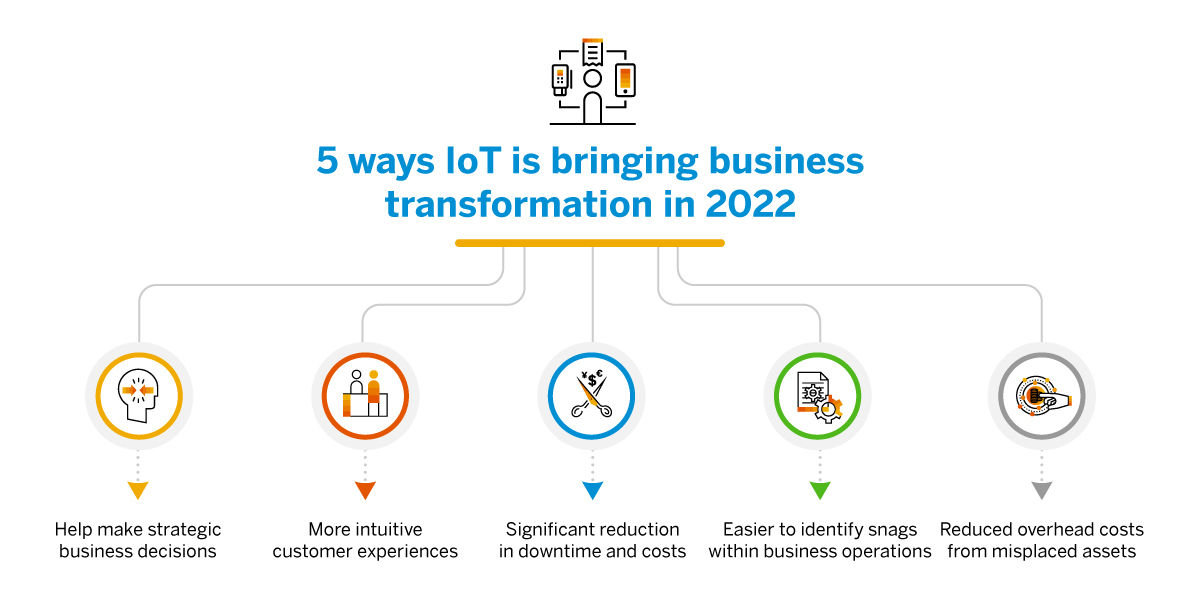According to reports published by IoT Analytics, global spending on enterprise Internet of Things (IoT) grew by 12.1% ($128.9 billion) from 2019 to 2020. Moreover, this report also suggests that global IoT spending is expected to grow at an annual rate of 226.7% post-2021. With such a promising trend, incorporating IoT into business processes can be vital to spearheading business transformation in 2022. This concept has been involved in helping businesses record data, boost overall operational efficiency, and make well-informed strategic decisions.

History of the Internet of Things (IoT)
Kevin Ashton, a Procter&Gamble (P&G) executive, coined the term ‘Internet of Things in one of his presentations in 1999. Kevin Ashton, at the time, was involved in the optimization of the P&G supply chain. He realized that the P&G warehouses could significantly improve their efficiency in real-time inventory tracking by using Radio Frequency Identification technology (RFID). However, the first application of IoT was a Coca-Cola vending machine (in the 1980s) that could record and send data online about the temperature and remaining stock of cold drinks.
Business Applications of IoT in the 21st century
IoT is essentially a technological platform that integrates several machines, each performing certain specific functions. These machines have built-in sensors that record real-time data like images, videos, motion, acceleration, temperature, etc., and can therefore provide valuable information for businesses. Here are some of the most popular applications of IoT that have led to business transformations in the 21st century.
- Smart Agriculture
Farming technology has been significantly revamped with the help of IoT networks. Modern progressive farms are now using humidity, temperature, and soil quality sensors that provide real-time data. These data are sometimes used by automated irrigation systems, eliminating manual labour and surveillance. There are several cases of such smart devices (including IoT-connected drones) rapidly reshaping the landscape of commercial agriculture in 2021.
- Retail and Supply Chain Management
One of the biggest business transformations that IoT has brought in the 21st century is in the retail and supply chain business processes. With the help of IoT-enabled technologies, retailers now have a greater degree of control over their inventory, warehousing, logistics, and point of sale processes. Amazon’s revolutionary ‘no checkout’ store incorporates an IoT platform that allows customers to shop in brick-and-mortar stores without having to wait in queues during check-out.
- Smart Energy Grids
IoT has facilitated the collection of data on electricity usage from several residential and business complexes. Electricity providers can analyze this data to ensure a higher level of power efficiency for enterprises. Moreover, installing sensors to detect power outages can also help manage the power grid better.
- Environmental Monitoring
Businesses have also resorted to using IoT-enabled sensors to record the quality of air, water, soil, and even patterns of weather to facilitate better decisions. Using these data, companies have ensured better environmental compliance and have added to their triple bottom line.
- Manufacturing
IoT has carved out its rightful place in the manufacturing industries as well. When it comes to business transformation in manufacturing, IoT-enabled connectivity across machines ensures higher operational efficiency. IoT platforms are also collating the data and analytics from these connected machines to develop detailed dashboards that illustrate the business performance and facilitate data-driven decision-making.

How can IoT Transform Businesses in 2022?
Recent reports have stated that about one trillion IoT devices may be in use worldwide by 2035. Reports have also suggested that the IoT market, by the end of 2021, is set to grow to $520 billion. To be a part of this revolution, you need to understand the five ways in which IoT is set to bring about a business transformation in 2022.

- Improved Business Insights
Whether manufacturing or agricultural, IoT transforms enterprises with improved business insights facilitated by real-time data collection. Enterprises are now witnessing a higher influx of real-time data with the help of connected devices like cameras, GPS trackers, and mobile devices. IoT platforms can integrate several such devices, enabling organizations to get constant insight into their business operations. Moreover, such an IoT network can also include Enterprise Resource Planning (ERP) software that can act as a data repository and help make strategic business decisions.
For example, an agricultural business that engages in animal husbandry would significantly improve several aspects by incorporating IoT-enabled devices. Such an enterprise could experience business transformation in the form of reduced livestock maintenance costs. Installing cameras, motion detectors, noise detectors, and thermal sensors in the livestock shelters to track livestock’s movement patterns and health conditions can help greatly. It can empower ranchers to respond to the health risks of livestock quickly.
- Improved Customer Experience
The most prominent way IoT rapidly transforms customer experiences is by increasing data inputs from customers themselves. By constantly monitoring customer actions and reactions through various IoT-enabled devices, companies can now provide more intuitive customer experiences. Moreover, emerging technologies like artificial intelligence (AI) and machine learning (ML) have further helped commercialize such big data. One of the most widely known applications of this is Amazon’s IoT ecosystem that consists of interfaces like the Echo, Echo Dot, and Alexa.
Amazon Web Services (AWS) have their own cloud-based platforms that provide storage for such real-time data collected through their IoT devices. Since cloud-based storage is easily accessible over the internet and does not have any physical address, AWS uses it to provide better customer experiences. Moreover, the advanced AI and ML software of Amazon also analyses this data to deliver tailored online shopping experiences to its customers.
- Cost & Downtime Reduction
Imagine a scenario where a vital piece of equipment in a manufacturing facility stops working, and it takes days to track and identify the problem. That can result in massive financial losses and days, sometimes even weeks, of downtime. Since IoT has infiltrated several large-scale manufacturing industries, 2022 will witness a significantly reduced downtime due to such equipment failures. With IoT solutions providers like SAP, businesses in 2022 will be able to monitor manufacturing equipment health seamlessly over the internet.
Since 2020, Samsung has incorporated IoT-enabled temperature sensors, motion trackers, and several other equipment health monitors in their 5G-powered smart factories. Such applications of IoT are set to increase rapidly with the adoption of Industry 4.0 technologies in 2022. Industry 4.0 (also known as the Fourth Industrial Revolution) is characterized by autonomous machines connected through the Industrial Internet of Things (IIoT). Therefore, 2022 will witness a smooth transition into autonomous manufacturing equipment communicating via IoT platforms.
- Increased Efficiency & Productivity
According to reports, the use of IoT in integrating different departments of an enterprise is set to provide an enormous $154 million revenue boost. Since IoT-enabled devices provide continuous real-time data of the surroundings inside a factory or even throughout the supply chain, it has become easier to identify snags within business operations. While this helps to increase operational efficiency, it also helps to improve output by facilitating extensive automation. As a result, aided by IoT connectivity, enterprises are set to witness increased productivity as well in 2022.
An interesting application of IoT in helping increase worker efficiency and productivity is demonstrated by Ford’s Valencia Engine Assembly Plant in Spain. Workers in this plant wear a bodysuit that has built-in motion and vital signs trackers. The real-time data collected from these bodysuits gets used to make working environments safer and more efficient for workers.
- Asset Tracking
Since a supply chain is involved with sourcing raw materials and delivering finished goods, there is always a chance for goods to go missing within this long chain of activities. Tracking goods (also known as assets) can often become a tedious job for warehouses and logistics partners. Using technologies like RFID and GPS tracking of each asset, companies can reduce overhead costs from misplaced assets. When such trackers connect to a larger network, it becomes easier for enterprises to keep tabs on their assets up and down the supply chain.
While companies like Siemens have also incorporated such IoT solutions to facilitate asset tracking and monitoring, an Enterprise Resource Planning (ERP) software provided by SAP may improve overall asset management. An ERP software helps to synchronize data and knowledge within all departments of an organization to facilitate higher efficiency and productivity. Providers of enterprise resource planning software like SAP have enabled businesses to step into this new world of IoT.
Conclusion
Several enterprises have experienced a business transformation by adopting IoT solutions, and providers like SAP are the forerunners of this Fourth Industrial Revolution. Markets such as remote patient monitoring are set to grow to $1.8 billion by 2026, and with developments like these, there is seemingly a huge scope for growth.
With the differentiation of IoT into several sub-sectors like the Internet of Medical Things (IoMT), Industrial Internet of Things (IIoT), Automotive Internet of Things (IoT), etc., the future of these technologies holds massive opportunities for businesses in 2022.



